I'm having trouble with cocobolo. I know it's a common occurrence, but anyone have suggestions for an oil finish? I have tried varnish twice, and it wouldn't dry even when I added japan drier to it. I used mineral spirits to clean off the uncured oil finish and used shellac sanding sealer, which is beautifully smooth and shiny, but I know it won't last. Can you apply oil over shellac? It's just a handle but this is getting frustrating. I want this to last.
-
It's time to cast your vote in the October 2025 Turning Challenge. (click here for details) -
Congratulations to Curt Fuller for "Bell Ornaments" being selected as Turning of the Week for October 27, 2025 (click here for details) -
Welcome new registering member. Your username must be your real First and Last name (for example: John Doe). "Screen names" and "handles" are not allowed and your registration will be deleted if you don't use your real name. Also, do not use all caps nor all lower case.
You are using an out of date browser. It may not display this or other websites correctly.
You should upgrade or use an alternative browser.
You should upgrade or use an alternative browser.
Cocobolo finish troubles
- Thread starter Nate Hawkes
- Start date
Oil is a supper wide descriptor these days. Hard to give advice when you don’t give details. You need a hot solvent when working on oily woods. I would use lacquer over the shellac if you want it smooth and shiny.
I had a similar issue with Padauk, but it was with polyurethane that wouldn't dry. After cleaning the poly off with MS and resanding, I put a coat of shellac sanding sealer on it. Once that was dry, I reapplied the poly. It took a little longer than usual to dry, but when it did, I got a shiny and durable surface.
I'm having trouble with cocobolo. I know it's a common occurrence, but anyone have suggestions for an oil finish? I have tried varnish twice, and it wouldn't dry even when I added japan drier to it. I used mineral spirits to clean off the uncured oil finish and used shellac sanding sealer, which is beautifully smooth and shiny, but I know it won't last. Can you apply oil over shellac? It's just a handle but this is getting frustrating. I want this to last.
My only experience with oil on cocobolo was a huge disappointment. I used "danish" oil on some Cocobolo with beautiful color. Within a few months it was almost as black as ebony. That might not have been bad but I could have used ebony if I'd wanted black.
Now I stick to shellac for cocobolo, occasionally lacquer, and sometimes just buff for a soft, non-glossy sheen.
JKJ
Is this a decorative item? I have had good results with walnut oil, letting it cure for quite a while, and then Beall buffing. Still shiny after a few years. If it was a utility piece the sheen would not last long upon washing. I believe if cocobolo darkens over time, it is due to UV exposure; an oil finish would not help in preventing this color change but would not hurt either
I use either lacquer or sand to a high sheen and then use carnauba wax applied with the Beall system. Cocobolo is always a challenge.
Tom Gall
TOTW Team
For many years my standard finish for all exotics, and most domestics, was a wipe on coat (sometimes two) of thin shellac (Zinsser spray on a cloth). When dry, scuff with #0000 steel wool (Liberon) or a very fine abrasive pad. Followed by a coat of Waterlox (or two). I'm sure any other oil finish will work as well.
. I believe if cocobolo darkens over time, it is due to UV exposure; an oil finish would not help in preventing this color change but would not hurt either
My experience is different. I have a lot of Cocobolo, some big pieces, and have made many things. Shellac, lacquer, or just buffing, it does darken slowly over several years time. But something in the off-the-shelf can of Watco Danish oil did indeed cause it to turn nearly black over a short time. Don't know what. The blackened piece was in a box on a shelf out of the light so I don't think UV was a significant factor. Other similar pieces in the same box with shellac friction polish finish did not turn black like that.
I took this picture in 2008. I gave one away, the other has not darkened significantly in 17 years. Shellac finish.
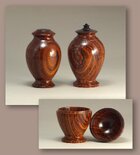
Of course something else could be going on, perhaps there is a difference in the wood itself and how it grew. Something in the soil. What animals fertilized the tree. Or who knows..
I made this during the fidget spinner craze in 2017. Still looks the same today. From a piece of the same Cocobolo, Gaboon Ebony, and brass, shellac finish.
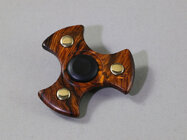
Also, based on some other data I wonder if more of the darkening might be more due to oxidation than UV. I base this on cutting into the middle of some very old Cocobolo, long rectangular pieces about 4x9" and 5x7", both so heavy I could hardly pick them up. (Most of the Cocobolo I use is from those two pieces.) From the situation, I suspect they are probably close to 100 years old now, supposedly stored with a lot of other wood in a room off the guy's shop. There was distinct darkening from the outer surface to maybe 3/8" towards the center. Seems to me that UV light, if even present in that storage room, might not easily penetrate that deeply. Don't know. Last time I checked I was still not a wood scientist specializing in exotics.
Years ago I also did a careful experiment with Purple Heart color change to brown after reading the light was the likely culprit. Turned out that surfaces were flat on a shelf were protected while the other surface exposed to air, either in a dim garage or on the windowsill in the kitchen exposed to the sun, both turned brown quickly. The surfaces protected by the flat shelf were still purple.
A possible interesting thing: I got a supply of purple heart from the son of a gentleman who had passed away long ago. This particular purple heart, unlike all other pieces I have, simply refuses to turn brown! Genetics, minerals in the soil, what? Made this from it; still looks the same years later. Shellac friction polish finish.
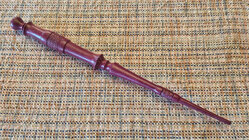
A guy who lived is South America told me they all thought US woodworkers were crazy to use purple heart. Where he lived the wood was used for floor joists, rafters, decking on docks, etc. He said the most sought after wood in his country was knotty pine from North America. Only the rich could afford that!
JKJ
What is the projected use of the piece? Shellac is a time-tested finish, used for centuries. It is rather soft and not resistant to alcohol, but for a decorative piece it should hold up just fine. You can adjust the sheen with careful abrasion/buffing. Why do you want to apply "oil" over it? Most "oil" finishes are thin and require re-application with heavy use, and over cocobolo will need a barrier coat of shellac anyway.
Never had any problems with Cocobolo, its rare and super expensive, never had any. 
But we do have couple of oily species, I have had to literally wash them in DNA or White spirits and use thinned out finish. Results have been mixed ,now I just dont bother.
But we do have couple of oily species, I have had to literally wash them in DNA or White spirits and use thinned out finish. Results have been mixed ,now I just dont bother.
I have yet to turn Cocobolo, I have turned some rosewood which I believe is similar. I simply used a wax finish after sanding to 1500 or 2000 grit.
Never had any problems with Cocobolo, its rare and super expensive, never had any.
A long time ago when I was starting out with turning I knew a guy who bought out the shop of an older gentleman and it came with a storage room full of wood. He decided to go into the business of selling wood. Great guy, but I think he knew about as much about wood than I did at the time - almost nothing. He marked some wood "claro walnut from california". I bought a small piece, took it home and turned it and fell in love. The figure, the color, the fine grain - cut so smooth it almost didn't need sanding. I went back and bought every bit in the stash. For example, two huge pieces were marked $25 each. It wasn't until I started studying wood ID that I examined the end grain with my stereo microscope and figured out what it was. I didn't know the value until I saw a small cocobolo log at a big dealer - pith, sapwood, and all - with a price of $600. One $25 piece was larger and longer and hand no sapwood or pith, obviously cut from a huge tree. I've been using pieces of that and the other big piece ever since.
It's actually a type of rosewood but much more distinctive and colorful than any of the other rosewood species I have in my stash. Expensive here but cheap elsewhere - in Costa Rica I couldn't find any wood for sale but I saw a lot of turned things in shops, priced as if they were made from pine. Brought a nice mug home.
Warning: Cocobolo is a known sensitizer and some people are or become highly allergic to it. I use good dust collection, wear an industrial respirator, and wash hand and arms after working with it. I know one guy who developed such a serious wood allergy from that and other wood he couldn't go into his shop even though it was professionally cleaned multiple times. He ended up moving to a newly built house and took up turning metal! I still have his wood lathe in one of my storage buildings
In 2007 I made a pair of salt and pepper mills for the house, from cocobolo and dogwood. Guess how I remember what's in which?
I think that was the first time I tried making two things as close to identical as I could manage. Those and Olive are my favorite species to turn.
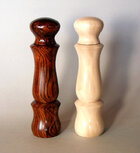
Makes great finger tops. I used shellac on all of these too. Excellent for hair sticks, conductors baton handles, "magic" wands.
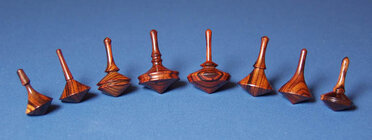
JKJ
Last edited:
Odie
Panning for Montana gold, with Betsy, the mule!
Color changes are going to happen naturally no matter what you do......so, just learn to appreciate what you get.
As I look through some photos of Cocobolo bowls that I've turned in the past, I see that some are darker than others. All of mine were done with Watco Danish oil natural and Beall buffed.
The only conclusion I can come up with, is each piece of Cocobolo wood (among other woods) is an individual example, and any color changes can happen differently, but it all happens naturally. Color changes aren't the result of what you do, or don't do.
You can slow down the color change if it's due to exposure to light, but you ultimately can't do a darn thing about it.
=o=
As I look through some photos of Cocobolo bowls that I've turned in the past, I see that some are darker than others. All of mine were done with Watco Danish oil natural and Beall buffed.
The only conclusion I can come up with, is each piece of Cocobolo wood (among other woods) is an individual example, and any color changes can happen differently, but it all happens naturally. Color changes aren't the result of what you do, or don't do.
You can slow down the color change if it's due to exposure to light, but you ultimately can't do a darn thing about it.
=o=
Cocobolo is so hard and oily, built up oil-based finishes have a tough time with it, and can just turn messy in time. Sanding as finely as you care to go, with a burnishing of its own shavings, is about the best you can hope for, the wood can take care of itself after that. When I turn it anymore, if I go with oil (really, the only finish in my shop), I go with just a dab and apply it and rag buff it off in the same step, turning at a higher speed. It won't absorb anything more than that. Follow right away with a favorite paste wax applied the same way, spinning fast for some heat and let it buff right back off.
Other than this, non-absorbing top coats like shellac, maybe lacquer (I've never used lacquer) are likely your best bet. A quick wipe of the bare wood with denatured alcohol before those surface finishes is warranted to remove any surface oil from the wood, to allow for good adhesion of the finish.
Other than this, non-absorbing top coats like shellac, maybe lacquer (I've never used lacquer) are likely your best bet. A quick wipe of the bare wood with denatured alcohol before those surface finishes is warranted to remove any surface oil from the wood, to allow for good adhesion of the finish.
The only conclusion I can come up with, is each piece of Cocobolo wood (among other woods) is an individual example, and any color changes can happen differently, but it all happens naturally. Color changes aren't the result of what you do, or don't do....You can slow down the color change if it's due to exposure to light, but you ultimately can't do a darn thing about it.
The Wood Database has an interesting article about this:
Preventing Color Changes in Exotic Woods | The Wood Database
Color change is one reason I keep in mind that form is king. It won't change with time. For light-color woods, dye may be an option.
JKJ
This is just for finishing a handle. Shellac dried without a problem, but I know it won't hold up too long to constant use. It is going to hold an Alan Lacer "uber skew". I now own both of his uber skew designs; a 1.5" and a 5/8". I use a skew much more often than a gouge when turning boxes.
This is just for finishing a handle. Shellac dried without a problem, but I know it won't hold up too long to constant use. It is going to hold an Alan Lacer "uber skew". I now own both of his uber skew designs; a 1.5" and a 5/8". I use a skew much more often than a gouge when turning boxes.
I like buying from Alan and have thought about that big skew. What kind of tang does it have?
I see from his description the shaft is tapered. Have you compared it to the Thompson 1-3/8"?
Cocobolo sounds like a good handle wood for a heavy skew. On some of my handles I don't use any finish, just texture in some way for a better grip then sand fairly smooth. Haven't made any from Cocobolo but from some other hard exotics like black ebony and bubinga and local persimmon and dogwood I sometimes just go over it with steel wool, maybe buff a bit.
JKJ
I can't remember how big the tang is on the large skew, but the 5/8" one is an 11/16" tang. I had a light handle for my 3/4" skew that I use all the time, but it's gotten very short. The 5/8" skew is longer than many; maybe 8". I haven't measured. It wouldn't have balanced well with another maple handle. I have a scraper with a persimmon handle. It turns beautifully. I wish I had more of it!
I love persimmon for handles. I have another one near the house that needs to come down - winter is the best time. Maybe I could dry and save a couple of handle blanks for you. As I mentioned before, we get to Staunton on occasion.I have a scraper with a persimmon handle. It turns beautifully. I wish I had more of it!
A couple of years ago this persimmon by the chicken house fell across the driveway in a storm and barely missed smashing my garden gate!
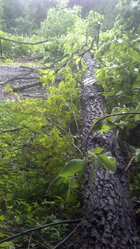
Also, I know a guy near here that had two HUGE persimmon trees near his house, seemed like close to 30" in diameter if my memory is right. He had one taken down earlier - I asked about the other and he said if I wanted it, just say the wood and we'd cut it. I never did but might check back with him. I have equipment and big trailers now and a sawmill and could easily handle the logs.
A persimmon tree that big might have some significant black heartwood, rare in a smaller tree.
JKJ
Handle blanks would be awesome! I was disappointed in the small amount of black in the 10" log I got. Unfortunately there wasn't enough wood that wasn't checked to make any bowls out of it. I have made a few boxes and it turns smoothly compared to other hardwoods.
Handle blanks would be awesome! I was disappointed in the small amount of black in the 10" log I got. Unfortunately there wasn't enough wood that wasn't checked to make any bowls out of it. I have made a few boxes and it turns smoothly compared to other hardwoods.
OK, I'll make a note and stick it up in my shop. Tell me the size squares and lengths and I'll write that on the note! If things work out we may be driving up 81 in spring or early summer.
Persimmon is a type of Ebony and turns like it (but you prob already know that)
A 10" diameter persimmon is likely to have a black in the middle not much bigger than a fat pencil lead.
That said, I occasionally (but rarely1) get some where the black flares in places, like I used for the handle on this meat tenderizer:

It's fun to find that when cutting up logs!
But usually when I see black it's sparse if it veers from the pith may follow the grain in a few rings like this. (I'm happy with that, too.)
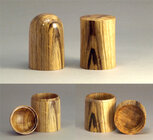
This handle is persimmon. I made an insert from brass to fit 5/8" shafts like the Thompson/StLeger 5/8" and 1" spindle roughing gouges.
I don't think I used a finish. (I got the 1" from Mark StLeger - he told me it was the last one. Doug T. told me they were too much of a pain to machine so he quit making them.)
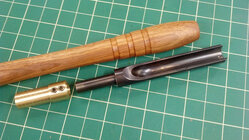
I made the other one with a 5/8" insert from Bubinga.
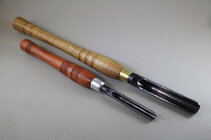
BTW, I love the U-shaped spindle roughing gouges made by several companies. Due to the way they are machined the sides (wings) are straight for a bit. When ground straight across you can rough cut with the curved part then roll the tool and use the wings like a skew.
I save every piece of persimmon. I got excited when a friend asked me to bring my truck since he was going to cut up one on the ground at someones house. I got a good pile - HOWEVER, it had been on the ground for a long time. Had more big grubs under the bark and burrowing into the wood than I'd ever seen. I'm drying a few pieces but haven't tried turning any yet. People who love wood with lots of defects (er, "character") might like it.
JKJ
Last edited:
I'd love anything you have at or larger than 2" and any length would be good but especially if you have some at the 16-18" size. I'd totally trade blanks if you make it up to Staunton. I've used most all my handle blanks as of late, but in general like fat handles. I had a tablesaw injury several years ago that left one of my fingers permanently straight, so I can't make a fist with my right hand. Most of my handles are close to 2" around to compensate.OK, I'll make a note and stick it up in my shop. Tell me the size squares and lengths and I'll write that on the note! If things work out we may be driving up 81 in spring or early summer.
Persimmon is a type of Ebony and turns like it (but you prob already know that)
A 10" diameter persimmon is likely to have a black in the middle not much bigger than a fat pencil lead.
That said, I occasionally (but rarely1) get some where the black flares in places, like I used for the handle on this meat tenderizer:
View attachment 78928
It's fun to find that when cutting up logs!
But usually when I see black it's sparse if it veers from the pith may follow the grain in a few rings like this. (I'm happy with that, too.)
View attachment 78930
This handle is persimmon. I made an insert from brass to fit 5/8" shafts like the Thompson/StLeger 5/8" and 1" spindle roughing gouges.
I don't think I used a finish. (I got the 1" from Mark StLeger - he told me it was the last one. Doug T. told me they were too much of a pain to machine so he quit making them.)
View attachment 78929
I made the other one with a 5/8" insert from Bubinga.
View attachment 78931
BTW, I love the U-shaped spindle roughing gouges made by several companies. Due to the way they are machined the sides (wings) are straight for a bit. When ground straight across you can rough cut with the curved part then roll the tool and use the wings like a skew.
I save every piece of persimmon. I got excited when a friend asked me to bring my truck since he was going to cut up one on the ground at someones house. I got a good pile - HOWEVER, it had been on the ground for a long time. Had more big grubs under the bark and burrowing into the wood than I'd ever seen. I'm drying a few pieces but haven't tried turning any yet. People who love wood with lots of defects (er, "character") might like it.
JKJ
RE Alan Lacer's skews, the "uber" skews are awesome. They're close to 1/2" thick at the tang and taper nicely to around 5/16", which makes it incredibly solid. I do almost all spindle roughing with peeling cuts now. I have a spindle roughing gouge but the skew leaves a better finish for me. Plus it gives street cred to be able to use a skew, lol!
Odie
Panning for Montana gold, with Betsy, the mule!
The Wood Database has an interesting article about this:
Preventing Color Changes in Exotic Woods | The Wood Database
www.wood-database.com
Color change is one reason I keep in mind that form is king. It won't change with time. For light-color woods, dye may be an option.
JKJ
Thanks JKJ......I believe I read either that article, or one with similar conclusions quite a few years ago.
=O=
